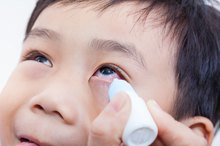Bloodshot Eyes in Children
Bloodshot eyes occur commonly in children, usually reflecting inflammation of the eye surface. This leads to dilation of tiny surface blood vessels and the appearance of bloodshot eyes. Although this symptom may be alarming, the underlying cause is often not serious. Common causes of bloodshot eyes in children include infections, allergies and irritants. See your healthcare provider for an accurate diagnosis and appropriate treatment if your child has bloodshot eyes.
Infection
Most cases of bloodshot eyes in children are due to a superficial bacterial or viral infection. Known as infectious conjunctivitis or pink eye, this condition involves infection of the thin membrane that covers the eye surface and the inside of the eyelids 4. It can be difficult to distinguish between viral and bacterial conjunctivitis as the symptoms overlap. However, thick eye discharge occurs more commonly with a bacterial infection. Clear, watery eye discharge is more likely with viral conjunctivitis. Infectious conjunctivitis can develop in association with a head cold, sore throat or an ear infection, but it can also occur on its own. One eye is commonly affected initially, but the infection typically spreads to both eyes.
- Most cases of bloodshot eyes in children are due to a superficial bacterial or viral infection.
- Infectious conjunctivitis can develop in association with a head cold, sore throat or an ear infection, but it can also occur on its own.
Allergies
Causes of White Eye Discharge
Learn More
Children with hay fever or other airborne allergies commonly develop eye symptoms, including slightly bloodshot eyes. Just as allergy-triggering substances in the air enter the nose and cause nasal symptoms, those same substances can get into the eyes and provoke an irritating allergic reaction. Airborne pollen, mold spores, animal dander and dust mite debris are common triggers for allergy-related eye symptoms -- a condition known as ocular allergy or allergic conjunctivitis. Children with ocular allergies typically experience simultaneous nasal allergy symptoms, including sneezing, stuffiness and a runny nose. Eye rubbing due to itchiness is also common. You might notice dark circles under your child's eyes, commonly known as allergic shiners.
- Children with hay fever or other airborne allergies commonly develop eye symptoms, including slightly bloodshot eyes.
- Children with ocular allergies typically experience simultaneous nasal allergy symptoms, including sneezing, stuffiness and a runny nose.
Irritants
Chemical or physical irritants might be to blame for your child's bloodshot eyes. Common culprits include:
- chlorine from a swimming pool
- smoke
- chemical fumes
- strong fragrances
- high wind,
- cold or dry air
Reflection of bright sunlight off water or snow can also irritate your child's eyes, leading to a bloodshot appearance. If your child wears contact lenses, overuse or sensitivity to cleaning or wetting solutions are possible culprits. Dust or dirt that gets into the eyes can cause physical irritation and redness. Rubbing the eyes in this situation might scratch the surface of the eye, leading to further irritation and discomfort.
- Chemical or physical irritants might be to blame for your child's bloodshot eyes.
- Common culprits include: * chlorine from a swimming pool
* smoke
* chemical fumes
* strong fragrances
* high wind,
* cold or dry air Reflection of bright sunlight off water or snow can also irritate your child's eyes, leading to a bloodshot appearance.
Other Causes
A Swollen Eyelid in a Child
Learn More
Rarely, bloodshot eyes in a child signal a potentially serious systemic disease or eye disorder. For example, Kawasaki disease causes widespread inflammation of the blood vessels of the body, which can manifest as bloodshot eyes along with reddened lips, palms and soles. Measles, chickenpox and fifth disease are other examples of childhood illnesses that can cause eye redness, along with a rash, fever and other symptoms.
Eye disorders that cause redness or bloodshot eyes occur more commonly in adults than children. However, children are sometimes affected. For example, an inflammatory eye disorder called uveitis may initially come to a parent's or healthcare provider's attention due to eye redness and pain. Light sensitivity is also typically present. Uveitis often occurs in conjunction with another illness, such as juvenile arthritis and certain types of kidney disease. Other inflammatory disorders of the eye called episcleritis and scleritis also rarely affect children and may lead to symptoms similar to conjunctivitis 4.
- Rarely, bloodshot eyes in a child signal a potentially serious systemic disease or eye disorder.
- Measles, chickenpox and fifth disease are other examples of childhood illnesses that can cause eye redness, along with a rash, fever and other symptoms.
Treatment, Warnings and Precautions
Although many conditions associated with bloodshot eyes in children are not serious, it's important to contact your doctor as soon as possible to determine the cause and initiate appropriate treatment. Therapy depends on the underlying cause. For example, antibiotic ointment or eye drops are usually prescribed for bacterial conjunctivitis. Antihistamines and artificial tears are often recommended for allergic conjunctivitis. A cool washcloth over the eyes can provide temporary relief from eye itchiness and discomfort, as well as light sensitivity. Keep in mind, however, that infectious conjunctivitis is highly contagious, so the washcloth needs to be laundered before reuse.
Urgent medical care is needed if your child has bloodshot eyes accompanied by severe tearing or light sensitivity, pus-like eye discharge, fever or rash. Seek emergency medical treatment if your child sustains an eye injury, complains of blurred vision or experiences moderate to severe eye pain. Emergency care is also needed if you suspect something might be in your child's eye, or if some type of chemical has splashed into one or both eyes.
Reviewed and revised by: Tina M. St. John, M.D.
- Although many conditions associated with bloodshot eyes in children are not serious, it's important to contact your doctor as soon as possible to determine the cause and initiate appropriate treatment.
- Keep in mind, however, that infectious conjunctivitis is highly contagious, so the washcloth needs to be laundered before reuse.
Related Articles
References
- Italian Journal of Pediatrics: Allergic Conjunctivitis: A Comprehensive Review of the Literature
- Infectious Diseases in Children: Pediatric Acute Bacterial Conjunctivitis: An Update
- JAMA: Conjunctivitis: A Systematic Review of Diagnosis and Treatment
- Review of Optometry: Conjunctivitis
- American Family Physician: Diagnosis and Management of Red Eye in Primary Care
- Pediatric Clinical Ophthalmology: A Color Handbook; Scott Olitsky and Leonard B. Nelson
- Merck Manual Professional Version: Overview of Conjunctivitis
- American Academy of Ophthalmology: Pediatric Anterior Uveitis
- Pediatric Ophthalmology and Strabismus; Kenneth W. Wright and Peter H. Spiegel
- Sheppard AL, Wolffsohn JS. Digital eye strain: prevalence, measurement and amelioration. BMJ Open Ophthalmol. 2018;3(1):e000146. doi:10.1136/bmjophth-2018-000146
- Javadi MA, Feizi S. Dry eye syndrome. J Ophthalmic Vis Res. 2011;6(3):192-8.
- Solano D, Czyz CN. Viral Conjunctivitis. StatPearls Publishing. Updated November 18, 2018.
- Putnam CM. Diagnosis and management of blepharitis: an optometrist's perspective. Clin Optom (Auckl). 2016;8:71-78. doi:10.2147/OPTO.S84795
- Duplechain A, Conrady CD, Patel BC, Baker S. Uveitis. StatPearls Publishing. Updated June 3, 2019.
- Shimizu A, Maruyama K, Yokoyama Y, Tsuda S, Ryu M, Nakazawa T. Characteristics of uveitic glaucoma and evaluation of its surgical treatment. Clin Ophthalmol. 2014;8:2383-9. doi:10.2147/OPTH.S72383
- Mclaurin E, Cavet ME, Gomes PJ, Ciolino JB. Brimonidine Ophthalmic Solution 0.025% for Reduction of Ocular Redness: A Randomized Clinical Trial. Optom Vis Sci. 2018;95(3):264-271. doi:10.1097/OPX.0000000000001182
- Hazlett L, Suvas S, Mcclellan S, Ekanayaka S. Challenges of corneal infections. Expert Rev Ophthalmol. 2016;11(4):285-297. doi:10.1080/17469899.2016.1203254
- Sahinoglu-keskek N, Cevher S, Ergin A. Analysis of subconjunctival hemorrhage. Pak J Med Sci. 2013;29(1):132-4. doi:10.12669/pjms.291.2802
- Petsas A, Chapman G, Stewart R. Acute angle closure glaucoma - A potential blind spot in critical care. J Intensive Care Soc. 2017;18(3):244-246. doi:10.1177/1751143717701946
- Salama A, Elsheikh A, Alweis R. Is this a worrisome red eye? Episcleritis in the primary care setting. J Community Hosp Intern Med Perspect. 2018;8(1):46-48. doi:10.1080/20009666.2017.1418110
- Yenerel NM, Küçümen RB. Pregnancy and the Eye. Turk J Ophthalmol. 2015;45(5):213-219. doi:10.4274/tjo.43815
- Portello JK, Rosenfield M, Chu CA. Blink rate, incomplete blinks and computer vision syndrome. Optom Vis Sci. 2013;90(5):482-7. doi:10.1097/OPX.0b013e31828f09a7
- Talhout R, Schulz T, Florek E, Van benthem J, Wester P, Opperhuizen A. Hazardous compounds in tobacco smoke. Int J Environ Res Public Health. 2011;8(2):613-28. doi:10.3390/ijerph8020613
- Vella LD, Cameron-smith D. Alcohol, athletic performance and recovery. Nutrients. 2010;2(8):781-9. doi:10.3390/nu2080781
- 1.Wu, Brian. "Red eyes: List of common causes." Medical News Today, 4 Mar 2017.
- 2. Chaudhary, Omar R, MD. "What causes red eye?" Eyesmart, American Academy of Ophthalmology, 17 June 2015.
Writer Bio
A retired federal senior executive currently working as a management consultant and communications expert, Mary Bauer has written and edited for senior U.S. government audiences, including the White House, since 1984. She holds a Master of Arts in French from George Mason University and a Bachelor of Arts in English, French and international relations from Aquinas College.









